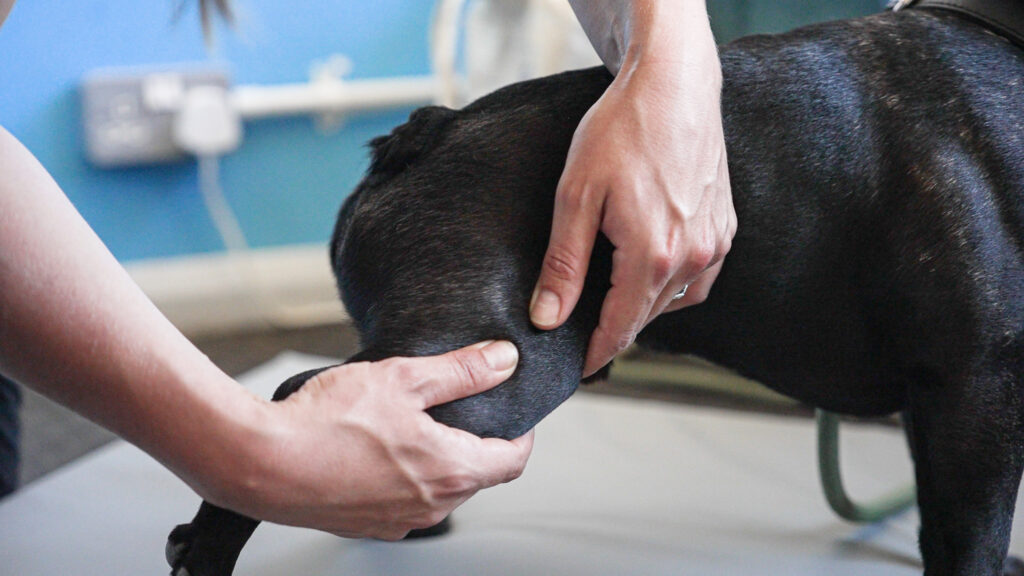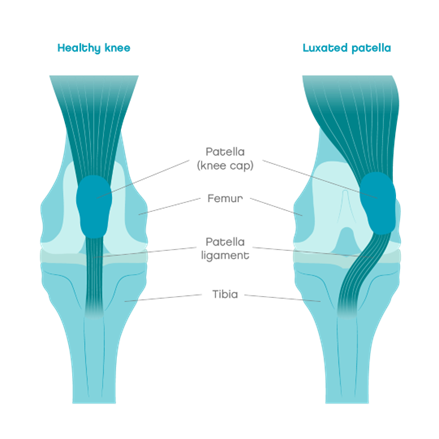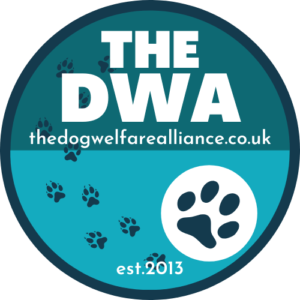How Apollo Animal Physiotherapy Can Help Your Dog With Luxating Patella Feel Comfortable, Stronger And Happier
It can be a worrying time after discovering your dog’s diagnosis of luxating patella. We can help you feel supported, and provide you with our knowledge and information to guide you through the steps of rehabilitation that can help improve your dog’s quality of life.
We can help your dog regain strength, comfort, and mobility while preventing further complications and reducing compensatory patterns.
What is Patella Luxation?
In a healthy knee, the patella sits in a groove on the femur and glides smoothly as your dog moves. In dogs with patella luxation, the patella pops out of place, either to the inside (medial) or outside (lateral) of the leg. The degree of luxation is graded from 1 (mild) to 4 (severe) with a mild patella luxation occurring intermittently and reducing into place. More severe grades occur more often, and in grade 4, the patella can sit permanently out of place.
What secondary complications can occur from luxating patella?
Due to the abnormal movement of luxating patella, secondary osteoarthritis can occur in the knee joint. This can cause pain, swelling and reduced mobility. Arthritis is not reversible, but luxating patella can be supported. Therefore it is important to rehabilitate the luxation before osteoarthritis progresses.
Abnormal strain on the knee can also predispose dogs to cruciate rupture (known as ACL in humans). This complication may require corrective surgery, particularly in larger dogs. However intense rehabilitation is required in all dogs.
Strain to local joints can occur such as the hips, and hocks (ankles) as well as the other hind limb. Compensatory patterns can lead to overuse of forelimbs, and increased muscle mass and high tone which can be painful when moderate.
It is important for us to manage the luxating patella, and prevent or manage any secondary complications during your dog’s rehabilitation programme.
Stories from our previous pet parents:
“Laura and Heidi have been brilliant with our mini dachshund Tassel who was diagnosed with Patella Baja . She is quite an anxious dog but they have worked hard to build a relationship with her and calm her down. Tassel has now had 3 sessions and there is a noticeable difference in her ability to walk . We were given regular daily physio exercises for her and loaned a K9 fit bone to do them on. We are very impressed with the service provided and outcomes so far.
We are amazed at the difference physio, laser and aqua therapy has made to Tassel. Her leg muscles are more visibly defined and most importantly she rarely limps anymore. Before on walks she would start to limp within minutes and often needed to be carried. Now although her walks are time restricted to 25 minutes and building, she walks well and steady. She is so much happier and is once again playing and greeting other dogs without becoming aggressive towards them. Laura and Heidi have done a fantastic job on her and built a rapport with Tassel who no longer resists going for treatments and in fact enjoys her physio routine at home as well . Very happy pawrent and customer.
Tassel has returned to Apollo for Laser therapy as the cold , damp weather was affecting her legs again. Needless to say Laura and Ellie got her back on her feet again and she is back to her usual happy self”
“I have been taking my french bulldog puppy to Apollo for just over a month now, as he is suffering with luxating patella’s in both knees.
He has been doing weekly hydro sessions and fortnightly therapeutic sessions along with daily home exercises and I am so amazed at the progress he has made already
I cannot thank Laura and Johanna enough for all their help and support so far!”
If you’ve noticed signs of kneecap instability in your dog, or they’ve already been diagnosed with patellar luxation, we’re here to help.

What Can You Expect from a Physiotherapy Plan?
At Apollo, we begin with a comprehensive assessment, followed by a custom-made treatment and exercise plan. This may include:
- Manual therapy for pain and soft tissue support
- Hydrotherapy to build muscle without weight-bearing strain
- Targeted strengthening and core stability exercises
- Home exercise guidance for continued progress
- Home management advice to make your home as comfortable for your dog
- Regular re-evaluations to track and adapt treatment
How Can Physiotherapy Help?
Rehabilitating for luxating patella focuses on improving joint stability, muscle strengthening, balance and coordination. We use evidence based therapies to help your dog feel comfortable, and stronger.
Pain management and comfort
Muscle Strengthening
Realignment Through Muscle Balance
Improving Gait and Movement Patterns
Supporting Post-Surgical Recovery
Contact Us
- 07300 020 514
- bookings@apolloanimalphysio.com
- apolloanimalphysio@gmail.com
- Apollo Animal Physiotherapy, Old Haine Road, Ramsgate, CT12 5AG







